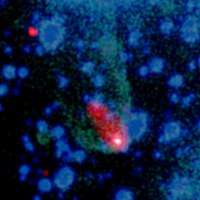Black Widow Pulsar
The Black Widow Pulsar (B1957+20) is an eclipsing binary millisecond pulsar in the Milky Way. Discovered in 1988, it is located roughly 6,500 light-years away from Earth. It orbits with a brown dwarf companion with a period of 9.2 hours with an eclipse duration of approximately 20 minutes. When it was discovered it was the first such pulsar known.[1] The prevailing theoretical explanation for the system implied that the companion is being destroyed by the gravitational environment (Roche lobe overflow) caused by the neutron star, and so the sobriquet black widow was applied to the object. Subsequent to this, other objects with similar features have been discovered, and the name has been applied to the class of millisecond pulsars with an ablating companion.
 The blue and green are optical images of the field in which the black widow pulsar is found, the green indicating the H-alpha bow shock. The red and white are secondary shock structures discovered in x-ray by the Chandra X-ray Observatory. | |
| Observation data Epoch J2000 Equinox J2000 | |
|---|---|
| Constellation | Sagitta |
| Right ascension | 19h 59m 36.77s |
| Declination | +20° 48' 15.12" |
| Apparent magnitude (V) | 20.4 |
| Characteristics | |
| B−V color index | 0 |
| Astrometry | |
| Details | |
| Rotation | 1.60734 ms |
| Other designations | |
| Database references | |
| SIMBAD | data |
Later observations of the object showed a bow shock in H-alpha and a smaller-in-extent shock seen in X-rays (as observed by the Chandra Space Telescope), indicating a forward velocity of approximately a million kilometers per hour.[2]
In 2010 it was estimated that the neutron star's mass was at least , and possibly as high as (the latter of which, if true, would surpass PSR J0740+6620 for the title of most massive neutron star yet detected, and place it within range of the Tolman–Oppenheimer–Volkoff limit).[3]
Gallery
Artist impressions of the black widow pulsar and its environment.
 Image of the pulsar surrounded by its bow shock. White rays indicate particles of matter and antimatter being spewed from the star. Its companion star is too close to the pulsar to be visible at this scale.
Image of the pulsar surrounded by its bow shock. White rays indicate particles of matter and antimatter being spewed from the star. Its companion star is too close to the pulsar to be visible at this scale. Image of the same pulsar one million times closer showing the effect of its wind on its companion star, which is evaporating. The bow shock is too large to be shown, and at this scale would extend more than 15 miles (24 km) beyond the edge of the computer screen.
Image of the same pulsar one million times closer showing the effect of its wind on its companion star, which is evaporating. The bow shock is too large to be shown, and at this scale would extend more than 15 miles (24 km) beyond the edge of the computer screen.
References
| Wikimedia Commons has media related to Black Widow Pulsars. |
- Fruchter, A. S.; Stinebring, D. R.; Taylor, J. H. (1988). "A millisecond pulsar in an eclipsing binary". Nature. 333 (6170): 237–9. Bibcode:1988Natur.333..237F. doi:10.1038/333237a0.
- Chandra X-Ray Observatory data for B1957+20 ""
- Van Kerkwijk, M. H.; Breton, R. P.; Kulkarni, S. R. (2011). "Evidence for a Massive Neutron Star from a Radial-Velocity Study of the Companion to the Black-Widow Pulsar Psr B1957+20". The Astrophysical Journal. 728 (2): 95. arXiv:1009.5427. Bibcode:2011ApJ...728...95V. doi:10.1088/0004-637X/728/2/95.